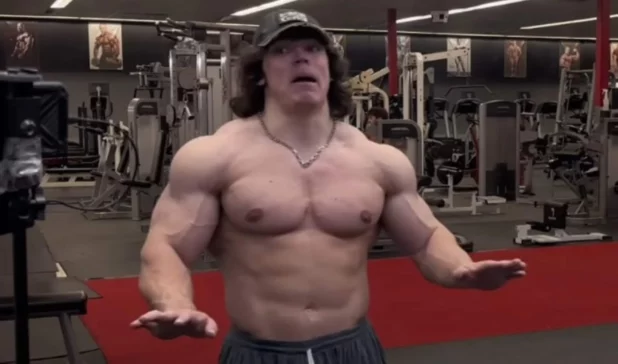Andrew Anglin has been telling you for years that steroids will make you gay.
Virtually everyone you think is in “good shape” is actually on steroids.
If you don’t know that, you don’t know anything about body-building or the way working out works.
Stephen Buranyi writes for The Guardian:
Dave is an ordinary office worker in the north of England. He is about average height for a British man – 5ft 10in – and to catch a glimpse of him between 9am and 5pm, the only hint that his leisure time is spent shattering the natural limits of human growth might be his slightly ill-fitting XXL shirt, or the fact that he sometimes wears women’s trousers, to better accommodate the steep slope between his trim waist and bulging thighs.
But in the videos and photos Dave posts online, to approving comments from other weightlifters (“huge progress 💪💪💪 ”), he is a total beast. His chest looks herculean, and the skin on his legs is pulled so tight that it has ceased to conceal the striated landscape of muscles underneath. Looking at him brings to mind the peeled-back diagrams of an undergraduate anatomy textbook. You can imagine attentive medical students poring over him, admiring the clarity – there the brachioradialis, there the palmaris longus. He looks impossibly strong, and he is. His record deadlift is 250kg, about the weight of three average men.
To get this body, Dave needed two things. First, the discipline to eat well, sleep well and work out intensely four to six times a week. And second, to take steroids. Like most users, he does so in cycles – periods of 8-20 weeks, up to two or three times a year. During his last cycle, in January of this year, he was taking 600mg of testosterone enanthate a week, injected – or pinned, in weightlifting jargon – into his buttock or thigh with a needle, and 40mg of oxandrolone a day, as an oral tablet. He is so far thrilled with the results, and not shy about discussing it. “I wouldn’t say it’s a taboo subject,” he told me. Someone at work recently asked him how he got so big and strong. “I replied simply: ‘steroids’,” he said.
At the end of his cycle, Dave gets blood tests from a private medical lab. These will show his testosterone levels crashing down, and ideally his alanine transaminase, an enzyme that serves as a proxy for liver health, remaining average – indicating that, to the best of his knowledge, his body tolerated the regime well. It is also likely, though harder to measure, that the walls of his heart are thickening, increasing his risk of heart attack. His testicles, freed from their job of producing testosterone by the influx of pharmaceutical chemicals, have partially atrophied, and, at the moment, Dave is injecting small amounts of testosterone every week, to keep his levels in the normal range for a man in his early-30s – a practice that he may have to continue for the rest of his life. He isn’t planning another cycle of steroids anytime soon. But “the temptation is always there”, he told me.
A decade or two ago, it would have been unlikely a white-collar office worker like Dave would have been so seriously into weightlifting, let alone steroids. But over roughly that period, steroid use has become perhaps more widespread than ever before. One early warning, according to Jim McVeigh, a Manchester Metropolitan University addiction researcher, was that workers at needle exchanges were seeing more and more steroid users show up at their services. And the trend appears to be accelerating. In a recent paper, McVeigh and his colleagues estimated that there are about 500,000 men in the UK between the ages of 15-64 who have used steroids in the past year. Joseph Kean, a drug and alcohol services expert who currently works commissioning public health services for Bradford council, believes the number might be double that. “We might have something like 70,000 steroid users coming into needle exchanges alone,” he told me. If the lower estimate is right, there are about as many steroid users as cocaine users among men in that age group. If the higher number is right, steroids are the second-most used illegal drug in the country, after cannabis.
In the UK, steroid possession is not criminalised – although they are illegal to sell – so it may have higher rates of use and disclosure than in other western countries. But it is clear that the steroids boom is not only a UK phenomenon. A study in the US using data going back to the 1980s suggests that up to 4% of men use steroids at some point in their lives. A recent smaller scale study published in 2022 found the rate of steroid use in adolescent boys in Minnesota was almost 7%. An analysis of 187 studies around the world found that in countries where data existed, 6.4% of men and 1.6% of women had used steroids at some point.
Over the past six months, I have spoken with more than 30 steroid users from different walks of life, as well as gym owners, former pro bodybuilders and powerlifters, fitness influencers and people familiar with the dealers who sell these drugs or cook them up in underground labs. What became clear through these conversations was that the values of previously marginal subcultures long associated with steroid use – such as bodybuilding or powerlifting – have increasingly entered the mainstream. They have flourished on social media, at the same time that larger cultural taboos around drugs and medical interventions have faded. The result is that more young men now feel drawn, or pushed, to transcend their natural limits in a way that would have seemed frightening or pathological to previous generations. As one 20-year-old in the West Country taking his first course of steroids told me, he was initially “terrified about the idea of sticking a needle with mostly unknown contents in”. Now, though, it’s as easy “as waking up and making a brew in the morning”.
I also spoke to doctors, scientists and harm-reduction workers who are studying the long-term effects of these drugs, many of which are still poorly understood. Some predict a tsunami of health problems crashing over the current cohort of users in two or three decades, burdening health services with their weak hearts and testicles, and currently only hinted-at cognitive impairments. In 2018 a group of prominent researchers published a review calling steroids a “hidden epidemic”, and a “looming public health threat” in the US. Other experts believe the effects can be managed. But one thing everyone I spoke with agreed on was that steroid use would continue to grow. “It’s not just a certain kind of person, certain region, certain gym,” says McVeigh. “What we have learned is: wherever we look for steroid use, we find it.”
…
There was, in all my conversations, a resignation that steroid use was only going to grow over the coming years. If that’s right, it will make understanding the long-term consequences “incredibly urgent”, says Findlay, the harm-reduction expert. “The question for us really, in medicine, is not why people are using, but what exactly the dangers are,” says Jayasena, the Imperial College endocrinologist. “A very rigorous study in Denmark showed us that over a decade, your overall chance of death taking steroids triples versus non users. That’s about the same risk as cocaine, but less than a third of heroin use,” he told me.
The basic medical consensus is that during the period when steroids are being taken, the risks are high. A study in Australia in 2020 showed that while taking steroids affected basic heart functions, after steroid use had ceased, the heart appeared to rebound, recovering over the course of a year or more. This is less true of the testicles. While many men will regain the ability to produce their own testosterone – and make viable sperm – for some, “it simply never comes back, and we’re not sure why”, says Jayasena.
Testosterone also has a potent effect on the mind. On this, I found there was a stark split between novice steroid users and veterans. Younger, or first-time users were often thrilled with the psychological benefits: “You’re the alpha everywhere you go. Confident, dominant and at times intimidating. You feel like you command respect. It’s wild,” the young man from the home counties told me. Older users tended to lament the side-effects. “One of my coaches used to call it ‘the burden’,” said Mike Istraetel, referring to the long-term feelings of deadened emotion, anxiety and the dips in mood that accompany cycles of steroid use. Israetel has been open in his videos about his own use, and often begins those discussions with the statement: “Steroids are not fun.” Another thing he said, echoing many other older men I spoke to, was that “steroids make you stupid”, citing deficiencies in memory and reasoning that come with regular use.
Astrid Kristine Bjørnebekk, a psychiatrist at Oslo university hospital in Norway, conducted one of the first large-scale studies on the effects of steroids on the brain. Her team scanned the brains of more than 80 people who had used steroids for at least a year, and compared the scans with non-steroid users. (To ensure the control group led a similar gym-based lifestyle to the steroid users, Bjørnebekk only included men who could bench press at least 225lbs.) They found that the steroid users had on average, smaller brain volume and significant reductions in grey matter. “It is not one small region being affected,” says Bjørnebekk. “It is the whole brain.”
…
Almost everyone I spoke to mentioned influencers. Strength training is huge on social media, and plenty of influencers have no truck with steroids. Some of today’s muscle-bound internet stars are what you might expect: brash, alpha types here to shout you into shape. But there are influencers for every audience. “If you want someone to drone on about studies and citations, you got it,” says Mike “Dr Mike” Israetel, a sports scientist and bodybuilder whose YouTube channel has 1.8 million subscribers. “You want someone to be super relatable and cool and not make you think too hard, you got it, too.” There are strength influencers for Asian moms, and ones for craft-beer nerds. Among the most popular at the moment are the Joe-Rogan adjacent, self-optimisation-obsessed More Plates More Dates channel, with 2 million YouTube subscribers, and Joey Swoll, a relentlessly positive himbo sort whose main non-lifting shtick is calling out instances of cyberbullying for his 4.4 million Instagram followers.
But the current king – and the person most mentioned by young men I spoke with – is Sam Sulek, a 22-year-old Ohian with 5.7 million Instagram followers. Sulek is a slab of pure lean meat with an 80s-rocker shag of black hair, and an affable style: plainspoken, no histrionics, lots of warm eye contact. When I asked people what they liked about Sulek they cited his humility and the way he seemed like an ordinary person. He shoots his videos in what appears to be a suburban family fitness centre. Indeed, Sulek is perhaps the perfect example of an influencer: in every way normal and relatable – someone like you, or someone you know – except for one almost unbelievably extreme quality, in this case being perhaps the most muscular person I’ve ever seen. (I stood near Sulek in a washroom at Arnold UK, and the width of his shoulders and back made taking a position at the urinal next to him essentially impossible.)
Sulek has stated that he does not use steroids, but his most famous predecessor, Arnold Schwarzenegger, has admitted to doing so in the past. In a 2017 paper on the history of gym culture, the sociologists Jesper Andreasson and Thomas Johansson note that Schwarzenegger didn’t just introduce bodybuilding to mainstream culture, he also pioneered a punishing, steroidal, aesthetically extreme version of it, and made the mainstream culture more aesthetically extreme as a result. (Last year, Schwarzenegger gave an interview to Men’s Health warning of the dangers of steroids.)
Every celebrity is on steroids. Every YouTuber promoting fitness is on steroids.
It is a way to humiliate men.
Women freak out and say that attractive, fit women should not be in advertisements. None of the Victoria’s Secret or Calvin Klein girls were ever on drugs.
Every celebrity male who young men are told they are supposed to look like is on drugs.
Sam Sulek
Here’s the deal: don’t be fat. Get fit and toned. Keep your posture in check.
That’s it.
If you want to do strength training, that is a good hobby and will increase your testosterone. But it will not make you look like any of these celebrities or YouTube people (unless you stop working and literally go to the gym for four hours a day).
Look at the statue of David:
That is what you should look like.
Except, hopefully, you have a bigger dick.
But if you don’t have a bigger dick don’t worry about it.
Honestly, now that I’m looking at it, you could definitely have bigger biceps and a bigger chest. I think basically David is the minimum. But you want to be lean and tone. You don’t want to look like a mutant creature.
If David is baseline, then I would say this Laocoön model is peak:
Notice he doesn’t have an out-of-control chest or traps. He’s just natty jacked.
Anybody bigger than that Hercules right there is on gear and is gay.
Steroids make you gay.
I you go to a Third World country where people don’t know that steroids have negative effects, so basically the trainers at the gym just give out steroids to everyone, people will tell you “if you go to the gym too much you will become gay.” They are not aware of the fact that everyone who goes to a Third World gym is on drugs.
Finally, please understand: being ultra-jacked does not get you laid.
Here are the physical attributes women respond to:
- Height
- Not being fat
That’s basically it.
I’ve been in incredibly good shape at various points in my life, and never gotten a comment from a woman. Men will comment all the time (not in a gay way, just in the same way you would comment on a guy’s cool car or shoes).
Primarily, women are only attracted to status, in the same way men are primarily attracted to a woman’s body. Maybe there are secondary factors about women you find attractive, but primarily, it’s her body. It’s the same thing with women and status.
The muscle thing is almost totally irrelevant to women – except that men respect other men for it, and that gives muscular men status.
Feel me?
Article updated to include the fact that the second statue is of Trojan priest Laocoön.




